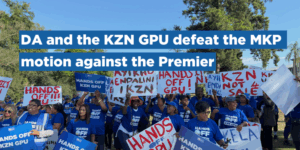Today, the City of Johannesburg held its Anti-Drug Summit in response to the scourge of drugs and substance abuse affecting some of our poorest and most vulnerable communities.
South Africa has twice the global average of substance dependency, and is number one in Africa.
Main drugs abused by South Africans include dagga, cocaine, tik, mandrax, nyaope, codeine, ecstasy and heroin. Dagga remains the most used drug on South African streets, amounting to just over 60% of all substance abuse treatment cases.
Johannesburg is, unfortunately, a microcosm of this.
The following were the overall objectives for the Anti-Drug Summit:
- to establish partnerships and strengthen existing partnerships to improve inter-sectorial collaboration with multi-disciplinary stakeholders, with vested interest in substance abuse prevention and treatment process;
- to launch the CoJ Integrated Strategy on Substance Abuse Prevention and Treatment;
- to launch the CoJ Local Drug Action Committee; and
- to contribute to reducing demand, harm and supply as prescribed by the National Drug Master Plan.
Prevention programs have been undertaken by various sectors over the years to address the problem. However, most have been amiss, owing to the lack of a comprehensive Integrated City Strategy in dealing with the scourge of drugs.
The impact of this scourge is seen in the many young people who live wasted lives, missing their potential and involving themselves in criminal activities.
In response to this, the City has partnered with the South African National Council of Alcoholism and Drug Dependency (SANCA) and the Community Anti-Drug Coalition of America, on an integrated, community- based and driven programme of action.
Most importantly, the City’s Anti-Drug Summit included contributions from other key role players in the City, including the Department of Public Safety, the Department of Health, Development Planning, Community Development, Social Development and Economic Development.
This Anti-Drug Summit focused on building an integrated strategy, aimed at supply reduction, demand reduction and harm reduction.
The integrated strategy resulting from the summit will inform, strengthen and improve program development and implementation, as guided by the National Drug Master Plan 2013-2017.
The City has already begun investigating the problem at its source, and will consider three aspects of intervention, namely, Prevention, Supply Reduction and Demand Reduction.
On Prevention, the programme will look at accelerated awareness functions and strengthening support to our city-wide Local Drug Action Committee (LDAC).
There is already a close understanding with the City’s Community Development Department to optimise recreation centers for young people to gain access to these facilities and prevention programmes currently being offered by the Social Development Department.
On the Supply Reduction aspect, the programme focuses on how drugs enter the country from external sources, and assesses issues of border control, intelligence, policing, local production and other sources.
The programme accelerates stakeholder integration and interaction, by bringing together the role players to establish role clarification and strengthening in reducing the supply of drugs in the country, and in the City of Johannesburg.
Here the identified role players include but are not limited to Home Affairs, SAPS, JMPD, NIA, HAWKS and other investigating and law enforcement agencies to provide direction.
Many reports have characterized South Africa as the largest market for illicit drugs in sub-Saharan Africa.
If we are to ever turn the tide against substance abuse, it is crucial for the National Department of Home Affairs, together with policing and customs authorities at ports of entry, prevent the entry of these illegal substance.
As evidenced by the crisis in our communities, our policing is not effective and we are seen as a haven for this criminal activity. This must come to an end.
I have also requested the MMC of Health and Social Development, Dr Mpho Phalatse, prepare representations for Parliament’s attention on this matter, so as to begin discussions regarding a cohesive and effective national response to our crisis.
We must also build a zero tolerance culture against drug dealers by continuing to encourage communities to come forward with information, and a culture of accountability, where corrupt police officials will also need to be dealt with.
On the Demand Reduction, the plan explores determinants of drug use and considers ways of addressing these. There is a huge focus on education, skills development, job placement, and programs to address social issues in our communities such as the absent father syndrome, etc.
Ultimately, the aim is to initiate a platform for the establishment of an interdepartmental and intergovernmental movement to address the drug problem, and to ensure that no young person is left behind.




